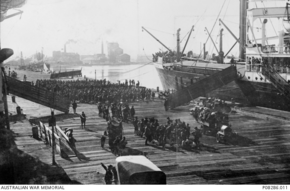
54633
STEVENS, Edgar
| Service Number: | 685 |
|---|---|
| Enlisted: | Not yet discovered |
| Last Rank: | Private |
| Last Unit: | Australian Flying Corps (AFC) |
| Born: | Gawler, South Australia, January 1872 |
| Home Town: | Not yet discovered |
| Schooling: | Not yet discovered |
| Occupation: | Pattern Maker |
| Memorials: | Gawler Council Gawler Men Who Answered the Call WW1 Roll of Honor, Glenelg and District WW1 & WW2 Honour Board, Norwood Primary School Honour Board |
World War 1 Service
| 25 Oct 1916: | Involvement Private, 685, No. 2 Squadron, Australian Flying Corps, --- :embarkation_roll: roll_number: '1' embarkation_place: Melbourne embarkation_ship: HMAT Ulysses embarkation_ship_number: A38 public_note: '' | |
|---|---|---|
| 25 Oct 1916: | Involvement 685, No. 2 Squadron, Australian Flying Corps, --- :embarkation_roll: roll_number: '1' embarkation_place: Melbourne embarkation_ship: HMAT Ulysses embarkation_ship_number: A38 public_note: '' | |
| 25 Oct 1916: | Embarked Private, 685, No. 2 Squadron, Australian Flying Corps, HMAT Ulysses, Melbourne | |
| 25 Oct 1916: | Embarked 685, No. 2 Squadron, Australian Flying Corps, HMAT Ulysses, Melbourne | |
| 28 Dec 1916: | Embarked AIF WW1, Private, 685, Australian Flying Corps (AFC), After embarking Melbourne in the ship 'Ulysses'. Arriving at Plymouth, England. | |
| 24 Aug 1917: | Embarked AIF WW1, Private, 685, Australian Flying Corps (AFC), Private STEVENS Edgar proceeded overseas to France. | |
| 28 Jun 1918: | Wounded AIF WW1, Private, 685, Australian Flying Corps (AFC), STEVENS Edgar was admitted into the hospital after being fit neurasthenic. | |
| 11 Nov 1918: | Involvement 685 | |
| 11 Nov 1918: | Involvement Private, 685 |
Help us honour Edgar Stevens's service by contributing information, stories, and images so that they can be preserved for future generations.
Add my storyBiography contributed by Adelaide Botanic High School
Private Edgar Stevens, born in January of 1872, in Gawler, South Australia. He was a part of the Australian Imperial Force, specifically the Australian Flying Corps, throughout World War I. Edgar enlisted on the 19th of September 1916, being 44 years old at the time and a pattern maker. He was unmarried and a Methodist for most of his life. His sister, Mrs Maniser Mary Elizabeth, was noted as his next of kin on the enlistment form. She lived in Port Pirie West.
Edgar Stevens embarked on the HMAT Ulysses A38 on the 25th of October 1916 from Melbourne, Australia, arriving in Plymouth, England on the 28th of December 1916. This was where his squadron, the 2nd Squadron Australian Flying Corps, formed the 68th (Australian) Squadron, Royal Air Force. This was later altered to 67 Squadron. He participated in military training during January of 1917, and was later deployed to France for service along the Western Front during September of 1917.
Edgar’s assigned role on the Western Front was to operate as an aircraft mechanic. During World War I, planes were still rudimentary in design, which is evident by looking at the Airco DH-5 planes used by Great Britain during the middle of World War I. These planes use a single 110 horsepower rotary engine, which spins a dual blade propeller, this being quite a complex system at the time. An aircraft mechanic’s job would be to maintain and repair damaged or faulty planes from upwards of 50 kilometers away from the front lines. This placement of troops so near the front lines was likely due to the inability of aircrafts to travel longer distances to receive maintenance.
Edgar Stevens operated as an aircraft mechanic during the battles of Baizieux, the 3rd Battle of Ypres and many separate successes whilst operating under the Royal Air Force’s command.
During the squadron’s time in France, they were conjoined with the newly formed 13th army wing, equipped with DH-5 aircrafts, and classified as a 'scout' squadron. Stationed at the French town of Baizieux, the squadron was first involved on the 2nd of October 1917, and then later were drawn into the 3rd battle of Ypres. During this battle, Edgar's squadron was strongly involved in on-ground battle, on the first day of which, squadron 67 had lost 7 of its 18 aircrafts. Then in December of 1917, 67 squadron was re-equipped with the new and updated SE-5 aircraft. Following these involvements, the squadron’s operations during the winter of 1917-18 were obstructed by harsh environmental conditions. On January 4th, 1918, the squadron was re-named as the 2nd squadron, Australian Flying Corps. In early 1918, the squadron saw success operating under the command of multiple Royal Air Force wings, including the 10th, 22nd and 51st.
Edgar Stevens’ last acts before being discharged were in service of the 2nd squadron, which was later combined with the 4th squadron (AFC), as well as the 46th and 103rd squadrons of the Royal Air Force, to make the 80th wing. The 80th wing was present in the Allied counter-offensive during June/July of 1918. These final acts were followed by Edgar being admitted into hospital for ‘Neurasthenia’, which is a medical condition and term used for muscle fatigue, headaches, or even emotional conflicts. This term was commonly used by WWI doctors to diagnose a mental disorder now known as PTSD, or post-traumatic stress disorder.









